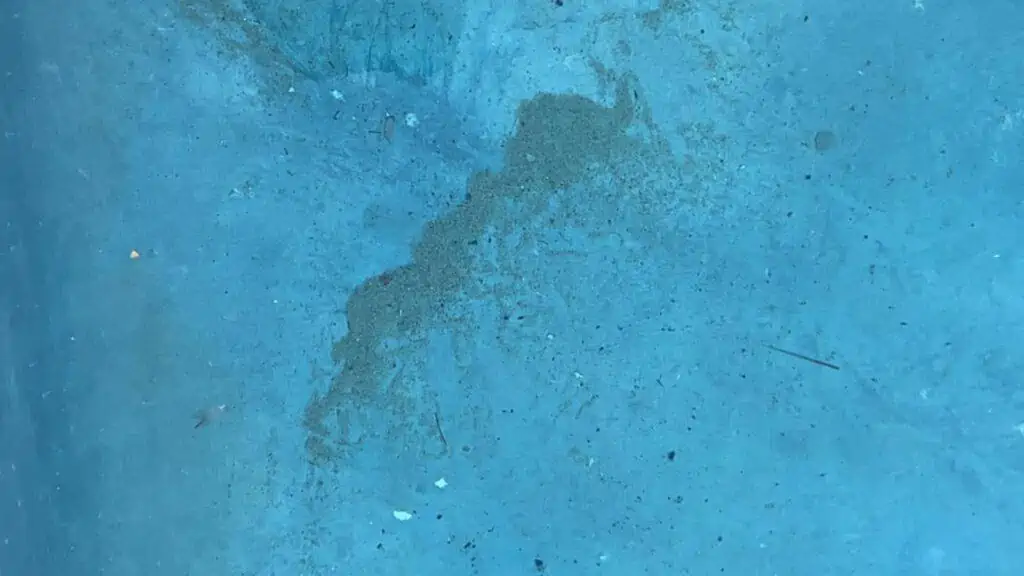If you have noticed sand piling up on your swimming pool floor lately, it means that there is something wrong with your sand filter – unless you live in a desert of course!
While some problems require help from a professional, there are a few ways you can fix the problem yourself.
Let’s take a look at some common reasons why your pool filter may be blowing out sand.

Common sand filter problems
In order to find out why your sand filter blowing sand in pool and how to fix it, you need to know what the problem is. Pool filters are responsible for helping to keep the water free from dirt and debris.
Noticing sand in your pool can be worrying, but most of the time it boils down to one of two problems.
You also might notice that there is sand coming out of the pool filter when backwashing which will be the result of the same problem.
Broken laterals
Working laterals are essential for sending filtered water back into the pool but leaving the sand behind. Laterals are a collection of six to ten pipes that can be found inside a pool filter that distributes the water through the sand evenly.
If you have one or more broken lateral, this means sand from the filter can enter the pipe which is how it ends up in the pool.
This is what sand filter laterals look like:
A complete standpipe and lateral assembly for most filters will not be very expensive so I personally wouldn’t bother just changing a cracked lateral but would change the entire assembly (unless the pool filter is quite new).
Broken seal
Rubber seals are used between the standpipe and the multiport valve to prevent the water and sand from mixing. If this seal is damaged, the sand and water begin to mix which turns the pool water cloudy.
Although these seals take on a lot of pressure over time, they begin to wear down due to the use of harsh chemicals.

Sand in pool, laterals not broken
If you’re finding sand in your pool but have confirmed that the laterals in your sand filter are not broken, there are several other potential reasons for this issue:
- Overfilled Sand Filter: If the sand filter is overfilled, it can lead to sand being pushed into the pool during the backwash and rinse cycles. Always ensure you fill the filter to the manufacturer’s recommended level.
- Multiport Valve Issue: The multiport valve, which directs water flow in and out of the sand filter, might be malfunctioning or have a worn-out gasket. If the gasket is damaged, it can allow sand to escape into the return line to the pool.
- Improper Sand Grade: Using the wrong grade of sand that’s too fine can lead to it being flushed out into the pool. Always use the recommended grade of sand for your specific filter.
- Old Sand: Over time, the sand in the filter can become smooth and start to compact. This can allow small particles to pass through and end up in the pool. Typically, sand should be replaced every 5-7 years, depending on usage and water conditions.
- Improper Installation or Assembly: If the sand filter was not assembled correctly after cleaning or maintenance, it might allow sand to bypass the laterals and enter the pool.
- Cracks in the Standpipe: The standpipe is another component of the sand filter system. If it has a crack or is damaged, sand can escape into the pool.
Repairing a damaged sand filter in 8 steps
Not all sand pool filters are the same. Some have the multiport valve on top of the sand filter housing while others do not.
The first image is a top-mounted sand filter and the second is a side-mounted one.
The easiest situation is where the multiport valve is separate and not on top of the filter housing. With this setup, it is much easier to unscrew the top of the filter housing as there is no pipework to disconnect before you can get to the filter top.
If your system is like this then just do the following steps but ignore the part about removing the multiport valve.
Step 1: Switch off the pool pump
Before you begin fiddling with the pool filter, you need to turn the water circulation system. Once switched off, you need to unscrew the plug located on the bottom of the filter to drain it.
Once the excess water has run off, it’s time for the next step.
Step 2: Unscrew the “lid”
Start by unscrewing the neck of the filter which holds the multi-port assembly to the filter. You will also need to unscrew the unions that hold the pipes together. Unions are designed to seal pool filters and act as an extra 0-ring.
Step 3: Remove the multi-port assembly
This can often be tricky as once the multi-port assembly is removed, you will need to quickly cover the standpipe to prevent sand from entering. We recommend using duct tape to cover the standpipe.
Next, you will need to remove the sand from the filter with a wet/dry vacuum. This may take a while and depends on how large the filter body is. Full details of how to remove the sand in a sand filter.
Step 4: Inspect the manifold
Now is the time to inspect for any damage. In order to lift the manifold safely from the filter, you will need to first lift the standpipe before moving the laterals into a straight position.
Use a garden hose to clean the manifold of debris and old sand. You should also inspect the laterals for any cracks or tears. If you do find cracks, they will need to be replaced immediately. The same applies to the standpipe. If you see any damage, you will need to replace it.
Step 5: Replace the manifold
Once you have cleaned the manifold and checked for damage to the standpipe and the laterals, you can place the manifold back inside the filter. Remember to bend the laterals back into their original positions. To prevent any further damage to the laterals, fill the filter halfway with water.
Step 6: Add sand to the filter
Keeping the standpipe in a centered position, add the required amount of new sand into the filter (do not reuse the old sand but use fresh sand). This will depend on the size of the filter and if you are unsure, always refer to the owner’s manual.
Don’t forget to remove the duct tape from the standpipe after you have put the fresh pool sand in.
Step 7: Inspect seal
Take a look at the 0-rings located at the bottom of the multi-port valve. If damaged, you will need to replace it immediately. Once you are happy with the seal, place the multi-port valve onto the standpipe and secure it tightly to the filter body. Inspect the seals on each union before they are secured to the multi-port valve and replace any that look worn or damaged.
Step 8: Backwash the filter
The last step is to backwash the filter for a couple of minutes to remove any dirt or debris from the sand. Then run the pump again on the “Rinse” setting before moving it back to the ‘Filter’ position once again.
I have this article if you are unsure what the pool filter settings mean.
That’s it – done!
Some advice from Matt Giovanisci of Swim University
How to remove sand from the bottom of your pool
Now that you have solved the problem of why was the pool filter blowing out sand into your pool it is time to remove the sand that is on the bottom.
Fortunately, this part is easy.
You just need to vacuum your pool on the filter setting as normal. The sand will be sucked up and deposited in your filter with the existing sand.
After following this guide, this should hopefully be the end of your blowing sand back into the pool issues. However, if you continue to find sand in your pool you can repeat the process again or call a professional.
Risks of adding too much sand to the filter
Adding too much or too little sand to the filter renders the filtering process ineffective. Of course, the water will still be filtered, but when too much sand is added, the process takes a lot longer and you will find yourself backwashing the filter more frequently.
What pool sand to use
Silica sand for pool filter
While there are a lot of different types of sand used in filters, the best one is silica sand. The most common type is #20 silica sand. It is made from ground quartz that has jagged edges. They are great at trapping particulates from passing water.
While you can use the other types of sand we mentioned before as well, they’re more expensive. Moreover, you might come across ‘recycled’ sand in pool stores. This kind of filter media may be used but you need to check it thoroughly to make sure it isn’t old and still coarse enough to get the job done.
FairmountSantrol AquaQuartz-50 Pool Filter 20-Grade Silica Sand
Glass sand for pool filter
Silica sand has a bad environmental impact but it is the best option available. If you are willing to spend more money, you can invest in glass sand. It has a lower environmental impact since it is made with recycled glass.
Also, glass sand can capture particles that are as small as two microns. That is one-millionth of a meter. The glass particles are sized differently so you don’t have to worry about channeling. Channeling is when pool water separates the sand and creates a smooth path for it to flow through.
This happens with sand once in a while. But it won’t ever happen with glass.
Another great benefit of using glass sand is that it can capture magnesium and iron particles. This is because of its negative charge.
LODOICEA 100% Recycled Swimming Pool Filter Media Glass
Zeolite pool filter sand
Zeolite sand is made with volcanic rock minerals. It has a greater surface area to volume ratio compared to normal silica sand because it has a honeycomb shape. This allows it to trap chloramines through a process called molecular sieving.
These byproducts of chlorine get trapped in the zeolite sand indefinitely. So you can avoid having to shock your pool regularly.
How long do sand filters last?
Although you may need to change the sand in a filter perhaps every 5 to 8 years, a good sand filter itself can last upwards of 25 years if maintained properly.
It is possible that during its life you may need to replace a lateral or two and perhaps replace the seal if it starts to leak.
Summary
Hopefully we have fully answered the question of why is my pool filter blowing out sand and shown you how to resolve the problem by replacing any broken or cracked parts or seals.
FAQs
What causes a broken lateral in a sand filter?
Generally broken or cracked laterals happen with age. All plastics degrade over time and will eventually fail.
How do I know if my sand filter laterals are bad?
The biggest tell-tale that you have broken laterals in your sand filter will be having sand at the bottom of your pool, particularly near the pool water returns.
How do you fix the laterals on a sand filter?
The only way to fix broken laterals in a sand filter is to replace them with new ones.
How long do sand filter laterals last?
Laterals in a sand filter can last a very long time, easily more than 10 years and even as much as twenty.
Why is sand blowing back into my pool?
The most common reasons why you have sand blowing back into your swimming pool will be either cracked laterals inside the pool filter body or a broken seal.












Leave a Reply